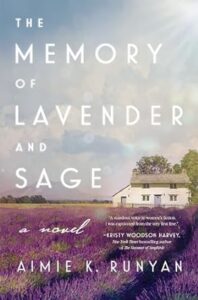by Aimie K. Runyan
I have written eight historical novels, and it’s no secret that creating an atmospheric setting—world building, if you will—is key to a deeply immersive reading experience. We recreate that moment in time, whether it’s 1889 Paris or 1942 in Siberia, deftly layering in details to make the reader feel as though they got hold of Doc Brown’s DeLorean.
Short descriptions of items in daily life that are different from the present day—connecting a call through an operator, for example—help transport the reader to the appropriate era in the space of a few words.
Recently, I released my first contemporary novel as a complement to my line of historical works. When mulling over the best strategy to keep fans of my historical works engaged in my modern-day novels—and, of course, to reach new readers—I realized that same immersive quality is key.
The Memory of Lavender and Sage is the story of a young woman from a wealthy New York family who goes to visit the village where her late mother grew up in Provence. As my contemporary debut, it’s a far more introspective novel than my historical titles, without the high tension of war and exterior conflict. Some historical novelists might assume contemporary fiction would be an easier feat, as it doesn’t require the same level of archival research, but I found it comes with its own set of challenges.
Here’s what I learned about how to create a narrative set in the here and now that has the same transportive effect.
Be diligent about the details.
Whether historical or contemporary, a sensory-rich novel requires the deft use of cultural details. An author shouldn’t bog the reader down with long descriptions of how the school system in Provence works, but a quick mention of how teachers are assigned at the national level and with only minimal regard for the preferences of the teacher candidates or the schools can be fascinating.
Research is still very much a part of the equation for contemporary works. Taking time to study the logistics of moving to a foreign country, learning how the medial system works, or yes, even studying the history of the region, will add dimension to a setting if you use that knowledge carefully.
To avoid is the dreaded “info dump,” sprinkle details with a light hand and save the interesting trivia that doesn’t serve the story for social media and other purposes.
Write to all the senses.
We writers often focus on the visual experience, and to a lesser degree the audio. This stands to reason, as most of us think cinematically, but describing touch, taste, and especially smell can add a powerfully evocative layer to the narrative.
Smell is so closely tied to memory in the human brain that even a brief description of a scent can deliver a huge visceral response in the reader.
And don’t neglect taste! I am a sucker for foodie fiction, and The Memory of Lavender and Sage definitely falls under that umbrella. A quick detail about a flavor or texture in foods helps relate the book to the reader on a primal level.
Take the trip.
Traveling to the area where the story takes place is a powerful, if expensive, tool to add depth to a story. I was exceptionally fortunate to be able to go to Provence while drafting The Memory of Lavender and Sage, and it gave me a better sense of the atmosphere in villages that I hadn’t visited in twenty years or more. This may be out of the reach, but if you can make it a budgetary possibility, it is invaluable in making a setting come to life. I try to get the most out of every research trip by making it benefit multiple projects whenever I can. If you can take promotional photos for one project, visit archives for another, and gather ideas for a third, it’s a lot of bang for the travel buck.
Armchair travel.
If you can’t hop on the next Air France flight, spend some time immersing yourself from the comfort of your own home. It will make a massive impact on your ability to describe the environments in your piece.
Fortunately, there are powerful online tools to help bring any contemporary real-life setting to life. For example, I have spent countless hours on street-view maps, watched and listened to videos to capture the sounds and spatial relationships in a village, and bookmarked news articles and opinion pieces about the decline of the French village and France’s “empty diagonal”. Taking the time to immerse myself in the culture and atmosphere of Provence helped to make the book an immersive sensory experience.
The setting in The Memory of Lavender and Sage is as crucial as any character in the book, crafted with that intention: to breathe the Mistral winds of Provence onto the page.

 Aimie K. Runyan writes to celebrate history’s unsung heroines. She has been honored as a Historical Novel Society Editors’ Choice selection, as a three-time finalist for the Colorado Book Awards, and as a nominee for the Rocky Mountain Fiction Writer of the Year. Aimie is active as an educator and speaker in the writing community and beyond. She lives in Colorado with her amazing husband, two (usually) adorable children, two (always) adorable kitties, and a dragon. Her debut contemporary novel, The Memory of Lavender and Sage, is new on shelves now.
Aimie K. Runyan writes to celebrate history’s unsung heroines. She has been honored as a Historical Novel Society Editors’ Choice selection, as a three-time finalist for the Colorado Book Awards, and as a nominee for the Rocky Mountain Fiction Writer of the Year. Aimie is active as an educator and speaker in the writing community and beyond. She lives in Colorado with her amazing husband, two (usually) adorable children, two (always) adorable kitties, and a dragon. Her debut contemporary novel, The Memory of Lavender and Sage, is new on shelves now.





